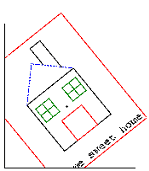| Pic.Rotate | Part of Pic module |
| Syntax | Pic.Rotate (picID, angle, x, y : int) : int
|
| Description | Pic.Rotate is used to create a new picture by rotating an
already existing picture. Rotation can either be around a specific
point in the picture (often used for rotating a picure in place) or
just a general rotation. The angle is specified in degrees. The rotation is done in a counter-clockwise direction. The original picture is not modified by the call to Pic.Rotate and must still be freed when no longer used. The picture produced by Pic.Rotate may be a different size than the original picture. The (x, y) point is the point around which the rotation is to take place and is relative to the picture being rotated. If it is not important to rotate the picture in place, x and y should be set to -1, which make the new picture the minimum size required to fit the rotated image.
|
| Details | The Pic.Rotate command can fail, in which case it returns 0.
The Error.LastMsg function can then be used to obtain more
information about the failure.
|
| Details | If x and y are set to a point in the picture (rather
than 1), it is possible for parts of the original picture to be
rotated off the left and bottom edge of the new picture. This occurs
because Pic.Rotate guarantees that the point specified by
(x, y) in the original picture will be located at
(x, y) in the rotated picture. You can avoid losing
parts of the picture by making certain there is a margin of background
color on the left and bottom sides of the picture.

|
| Details | Rotation can be slow on older machines. Programs that are using
animation should create and store all the rotated images that may
be needed. Often pictures of an object at various angles are stored
in an array.
|
| Example | This program draws “Hello” on the screen rotated at 0, 45 and 90
degrees.
View.Set ("graphics:200;150,nobuttonbar")
var f : int := Font.New ("Serif:36")
Font.Draw ("Hello", 10, 10, f, black)
var pic : int := Pic.New (5, 5, 120, 45)
var pic45 : int := Pic.Rotate (pic, 45, -1, -1)
var pic90 : int := Pic.Rotate (pic, 90, -1, -1)
Pic.Draw (pic45, 5, 50, picCopy)
Pic.Draw (pic90, 150, 5, picCopy)

|
| Execute | |
| Example | This program moves a spinning “Hello” around the screen, bouncing it off the edges of the output window. Notice that the original picture contains adequate space on the left and bottom sides to contain the rotation.
View.Set ("graphics:300;250,nobuttonbar")
var pic : array 0 .. 35 of int
var f : int := Font.New ("Serif:36")
const CTR : int := 57
Font.Draw ("Hello", 5, 45, f, black)
Draw.FillOval (CTR, CTR, 3, 3, brightred)
pic (0) := Pic.New (0, 0, 115, 115)
cls
for angle : 1 .. 35
pic (angle) := Pic.Rotate (pic (0), angle * 10, CTR, CTR)
end for
var x : int := CTR
var y : int := CTR
var dx : int := 1
var dy : int := 1
loop
for angle : 0 .. 35
Pic.Draw (pic (angle), x - CTR, y - CTR, picCopy)
if x + dx < CTR or x + dx > maxx - CTR then
dx := dx
end if
if y + dy < CTR or y + dy > maxy - CTR then
dy := dy
end if
x += dx
y += dy
delay (50)
end for
end loop
|
| Execute | |
| Details | Note that the rotated picture is a newly created picture. When it
is no longer needed, its memory should be released by using
Pic.Free.
|
| Status | Exported qualified. This means that you can only call the function by calling Pic.Rotate, not by calling Rotate.
|